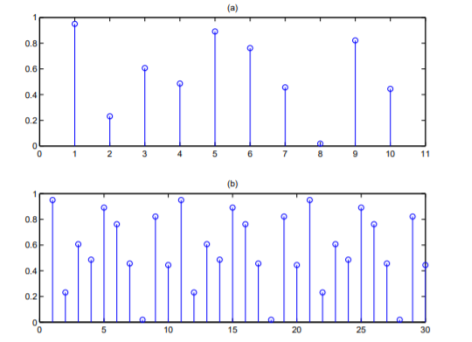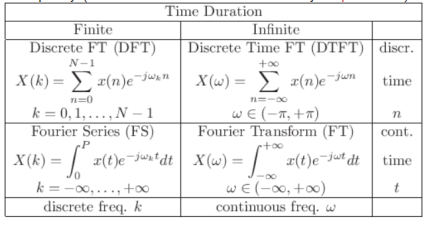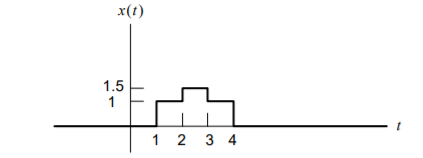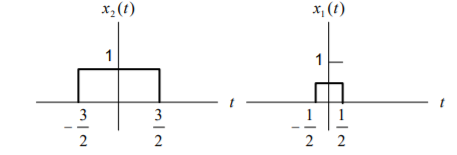Unit - 5
Fourier Representation for Signals -2
Let f(t) be the continuous signal which is the source of the data. Let N samples be denoted f[0],f[1],f[2],………..,f[k],…….,f[N-1]. The Fourier Transform of the original signal f(t) would be F(jw) = Each sample f[k] as an impulse has area f[k]. Then since the integrand exists only at the sample points: F(jw) = = f(0) e -j0 + f[1] e -jwT + …… + f[k] e -jwT + …. F(N-1) e -jw(N-1)T That is F(jw) = The continuous Fourier transform could be evaluated over a finite interval usually the fundamental period rather than from -∞ to ∞ . Similarly, since there are only a finite number of input data points, the DFT treats the data as if it were periodic form f(N) to f(2N-1).
Figure.1 (a) Sequence of N=10 pts. (b) implicit periodicity in DFT Since the operation treats the data as periodic, we evaluate the DFT equation for the fundamental frequency (one cycle per sequence, 1/NT Hz, 2π/NT rad/sec and its harmonics at w=0. In general F[n] = F[n] is the Discrete Fourier Transform of the sequence f[k]. In matrix form we get
Problem : Find the DFT of the sequence f(n) ={ 8,4,8,0} F[n] =
Figure2. Magnitude of the four point sequence. The inverse transform of F[n] = That is f[k] = 1/N
Key Takeaways:
|
The Fourier transform pair in the most general form for a continuous and aperiodic time signal x(t) is (Eqs. 1 and 2 : X(jw) = x(t) = 1/2π The spectrum X(jw) is expressed as a function of jw because the spectrum can be treated as the Laplace transform of the signal X(s) evaluated along the imaginary axis ( X(jw) = X(s) |s=jw in general s=
However, in practice, it is more convenient to represent the frequency of a signal by f=w/2π in cycles/ second or Hertz (Hz, KHz, MHz, GHz, etc.), instead of w in radians/second. Replacing w by 2πf, we can also express the spectrum as X(j2πf) or simply X(f) in this alternative representation:
X(f) = x(t) = Key Take Aways: CTFT deals with nonperiodic signals 5. 3 Properties (i) Linearity
Then
(ii) Time shifting
Then
Find the Fourier transform of the signal as shown in figure
Figure 3. Input signal
This signal can be obtained as a linear combination of x(t) = ½ x1(t-2.5) + x2(t-2.5)
Figure 4. Combination of x1(t) and x2(t) where x1(t) and x2(t) are rectangular pulse signals and their Fourier transforms are X1(jw) = 2 sin (w/2) / w and X2(jw) = 2 sin (3w/2)/w Using linearity and time shifting properties of Fourier transform yields X(jw) = e -j5w/2 { sin(w/2) + 2 sin(3w/2) /w}
Figure5 . The output waveform Conjugate Property:
Then
Differentiation and Integration
Then
Consider the Fourier transform of the unit step x(t) = u(t). We know that
Also note that x(t) = The fourier transform of this function is X(jw) = 1/jw + π G(0) δ(w) = 1/jw + π δ(w)
Where G(0) =1 .
Find the Fourier transform of the function x(t) as shown in figure.
Figure6 . Input signal x(t) and its interpretation From the above figure we see that g(t) = d x(t) /dt is a sum of rectangular pulse and two impulses. G(jw) = (2 sin w/w) – e jw – e -jw Using integration property we obtain X(jw) = G(jw) / jw + π G(0) δ(w) = 2 sin w/ j w 2 – 2 cos w / jw It can be found that X(jw) is purely imaginary and odd which is consistent with the fact that x(t) is real and odd.
Time and Frequency scaling
Then x(at) = 1/ |a| X(jw/a)
Parseval’s relation
We have
Parseval’s relation states that the total energy may be determined either by computing the energy per unit time |x(t)| 2 and integrating over all the time by computing the energy per unit frequency |X(jw)| 2 / 2 π and integrating over all frequencies. For this reason |X(jw)| is often referred to as energy-density spectrum. Convolution properties
Multiplication property
Multiplication of one signal by another can be thought as one signal to scale or modulate the amplitude of the other consequently the multiplication of two signals is referred to as amplitude modulation. Key Takeaways
|
References:
- Signals and Systems by Simon Haykin
- Signals and Systems by Ganesh Rao
- Signals and Systems by P. Ramesh Babu
- Signals and Systems by Chitode














































